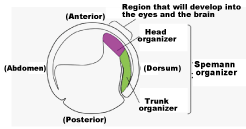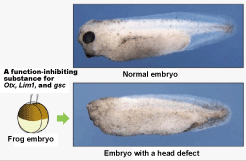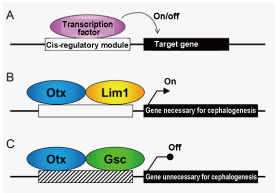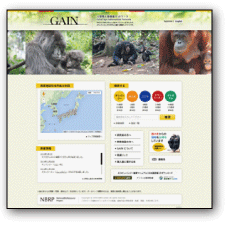|
 |
■Bioresources information is available at the following URLs)
|
 |
|
Research and Bioresources <No. 19> Elucidation of the Mechanisms Involved in Head Development in Animals Using Frog Eggs as a Model Organism
Yuuri Yasuoka, Marine Genomics Unit, Okinawa Institute of Science and Technology
Graduate University,
Japan Society for the Promotion of Science (Postdoctoral Fellow)
Various forms of animals complete a series of morphological changes from fertilized eggs to adult stage; these changes are known as the developmental process. Evolution of the developmental process directly reflects the evolution of animal morphology. Genomic DNA sequences of various animal species have been determined recently, and many developmental genes (proteins) have been found common among all animals, including sea anemones, flies, and humans. I have been interested in animal evolution from the very beginning of my research. When I entered the graduate program, I decided to study "how animals utilize genes that are common for developmental processes of all animals to create their unique forms." Using bioresources of the tropical clawed frog (Xenopus tropicalis), whose complete genome has been sequenced, the function of the Otx protein, which is involved in cephalogenesis of many animals, has been partially elucidated. I would like to introduce the study that partially elucidated the function of the Otx protein in this article.
|
How does the frog head develop from the fertilized egg? |
The Spemann organizer is a tissue that acts as a control tower and takes full responsibility for creating basic forms in the early development of vertebrates (Fig. 1).
The Spemann organizer consists of the head organizer and trunk organizer, responsible for cephalogenesis and notogenesis, respectively. In the case of the tropical clawed frog, the head organizer region is formed within the first 12 hours after the fertilization. The clear cephalic organs, such as the eyes and the brain, are formed within the next 12 hours. Subsequently, the nerves and muscles are formed, and the embryo begins to move. Within approximately 24 hours after the fertilization, dynamic changes occur in the frog embryo, which commence from the moment the Spemann organizer is defined.
|
|

Fig. 1: Cross section of the developmental stage of a gastrula in the tropical clawed frog
The embryo has anteroposterior and dorsoventral patterning already at this stage. The head organizer is located in front of the Spemann organizer. The head organizer sends signaling molecules to the region of the future head tissues, such as the eyes and the brain, inducing cell differentiation. |
|
Genes involved in cephalogenesis |
|
Many genes have been identified to be involved in the formation of the head organizer. In particular, otx is essential for cephalogenesis in flies and commonly expressed in animals with the head. Along with otx, lim1 and goosecoid (gsc) are involved in cephalogenesis in embryos of vertebrates
When a substance that inhibits the expression of these genes was injected into a frog embryo using a glass needle under a microscope, the embryo subsequently developed the head, the eyes, and the brain with defects (Fig. 2). This result indicates that these genes play essential roles in the cephalogenesis of the frog embryo. We then analyzed the whole genome in order to elucidate the detailed molecular mechanisms involved in cephalogenesis. |
|

Figure 2: Function-inhibiting experiment for otx, lim1, and gsc genes in frog embryos |
|
Relationship between genomic DNA and proteins |
|
otx, lim1, and gsc, the genes that are present in animal genomes, code for Otx, Lim1, and Gsc proteins, respectively. These proteins belong to the group of “transcription factors,” which bind to specific genomic DNA sequences named cis-regulatory modules and adjust the on/off switch of the “target genes” located near the modules (Fig. 3 A). To understand the functions and roles of the transcription factors, it is necessary to elucidate where the transcription factors bind on the genome and how and what genes they control.
Using frog embryos as model organism, we performed chromatin immunoprecipitation sequencing (ChIP-seq) of the Otx, Lim1, and Gsc proteins. The protocol of this method is as follows: (1) a complex of the DNA molecule and proteins (chromatin) obtained from an embryo is fragmented; (2) the chromatin fragments are mixed with an antibody that can recognize the target protein; (3) the chromatin fragments that contain the target protein are collected; (3) the base sequence of the DNA, which is part of the collected chromatin fragments, is determined; and (4) the genomic region, which is the binding site of the transcription factor, is identified. Consequently, Otx, Lim1, and Gsc proteins have been found to bind to several thousands to tens of thousands of genomic regions throughout the head organizer. |
Otx protein is essential in cephalogenesis |
|
We thoroughly investigated the relationship between the results obtained by performing ChIP-seq and the target gene. Consequently, it was revealed that when both Otx and Lim1 proteins bind to a specific cis-regulatory module, a gene necessary for cephalogenesis is switched on (Fig. 3 B).
It was also revealed that when another type of cis-regulatory module binds to both Otx and Gsc genes, another gene that is not involved in cephalogenesis is switched off (Fig. 3 C)
These results indicate that the role of the Otx protein is to provide a landmark of the "head," whereas binding of the Otx protein to a cis-regulatory module along with the transcription factor, which is the partner of the cis-regulatory module, switches on or off the genes and thus determines the type of the head that will develop. The universal principle of animal morphology states that the cis-regulatory module determines the type of the head in each animal although the same otx gene is used. |
|

Fig. 3: (A) Function of a transcription factor, (B and C) Models of cephalogenesis caused by Otx protein in vertebrates |
|
This study, which analyzed the developmental mechanism of the head organizer using frog embryos, is an important groundwork for understanding the evolution of the animal head. Our future task is to compare the function of the Otx protein between the tropical clawed frog and other animal species. At present, I am studying the evolution of the notochord, a tissue derived from the trunk organizer, using the bioresources of Ciona intestinalis in addition to those of X. tropicalis.
I expect that a large number of cross-sectional studies will be conducted beyond animal species, following the preparation of bioresources of many model animals.
|
| |
Reference |
| |
Yasuoka Y. et al., Occupancy of tissue-specific
cis-regulatory modules by Otx2 and
TLE/Groucho for embryonic head specification. Nature Communications 5:4322 (2014)
|
|
|
|
Great Ape Information Network "GAIN"
|
| |

・Number of chimpanzees: 320
・Number of bonobos: 6
・Number of gorillas: 25
・Number of orangutans: 49
・Number of gibbons: 179
(As of February 2015) |
|
| DB name: GAIN |
| URL:
http://www.shigen.nig.ac.jp/gain/ |
| Languages: Japanese, English |
| Original contents: |
| |
・ |
Information (name, parents' names, sex, species/subspecies, date of birth, place of birth, feature, character, life history, photographs, and references) about individual apes (chimpanzees, bonobos, gorillas, orangutans, and gibbons) in Japan |
| |
・ |
Information about breeding facilities |
| |
・ |
Guidance for researchers and breeding facilities |
| |
・ |
Introduction of books on apes |
| |
・ |
Reports on the activities and results of the GAIN |
| Features: |
・ |
Provides abundant information about individuals in liaison with breeding facilities. |
| |
・ |
Pedigrees can be displayed according to "all facilities," "specific facility," and "each individual." |
| |
・ |
Breeding facilities are displayed on Google Maps. |
| |
・ |
Displays a large number of photographs. |
| |
・ |
Displays chronological tables with breeding histories of individuals. |
| Cooperative DB: NBRP GAIN, breeding facilities, NBRP Information |
| Management organization: Genetic Resource Center, NIG |
| Year of first DB publication: 2002 Year of last DB update: 2015 |
|
Comment from a developer:The GAIN is an epoch-making database that covers all apes (chimpanzees, bonobos, gorillas, orangutans, and gibbons) in Japan. Information about individual apes is updated almost in real time through the network and permanently stored. The accumulated information is provided via various visual display methods using pedigrees, chronological tables, and Google Maps as well as delicate devices that have been adopted in these methods. Information about individual apes provided by the Primate Research Institute, Kyoto University, contains the results of the research projects and includes anthropometric data, chromosome images, and microarray data. The design of the GAIN was overhauled in April 2014. At present, the GAIN is easy to understand . It should be interesting to go to a zoo using information displayed in the GAIN as a preliminary knowledge about the features and characters of individual apes.
| |
|